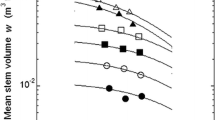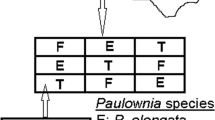Abstract
Density effects on the growth of self-thinning Eucalyptus urophylla stands were examined for 7 years. Tree height and stem diameter at breast height were measured during the experimental period. Stems, branches, leaves, bark and roots of 45 E. urophylla trees were sampled in three different density stands in order to establish their biomass equations. Change trends of the biological time τ and density ρ were described used corresponding equations. The stem weight ratio increased and leaf weight ratio decreased, whereas those of branch, bark and root were relatively steady from 2 years after the planting. The competition-density (C-D) effect equation of mean organ weight w o was derived by combining the allometric power relationship between mean tree weight w and w o with the C-D effect equation of self-thinning stands. The equations of the C-D effect for w and ρ and for w o and ρ were used to describe the C-D effects in tree and organs during course of self-thinning, respectively, and showed a good fit to the data. Leaf biomass of different density stands reached a more or less constant level with time elapse. High density produced the greatest biomass and stem biomass, so that it is the best choice in silvicultural practice.







Similar content being viewed by others
References
Alcorn PJ, Pyttel P, Bauhus J, Smith RGB, Thomas D, James R, Nicotra A (2007) Effects of initial planting density on branch development in 4-year-old plantation grown Eucalyptus pilularis and Eucalyptus cloeziana trees. For Ecol Manag 252:41–51
Beadle CL, Inions G (1990) Limits to growth of eucalypts and their biology of production. In: Dargavel J, Semple N (eds) Prospects for Australian forest plantations. Centre for Resource and Environmental Studies, ANU, Canberra, pp 183–193
Beadle CL, Mummery DC (1989) Stand growth and development of leaf area index in young plantations of Eucalyptus nitens at 2 × 2 m spacings. N Z For Res Inst Bull 151:254–258
Berger U, Piou C, Schiffers K, Grimm V (2008) Competition among plants: concepts, individual-based modeling approaches, and a proposal for a future research strategy. Perspect Plant Ecol Evol Syst 9:121–135
Bernardo AL, Reis MGF, Reis GG, Harrison RB, Firme DJ (1998) Effect of spacing on growth and biomass distribution in Eucalyptus camaldulensis, E. pellita and E. urophylla plantations in southeastern Brazil. For Ecol Manag 104:1–13
Cole E, Newton M (1987) Fifth-year response of Douglas-fir to crowding and non-coniferous competition. Can J For Res 17:181–186
Cromer RN (1996) Silviculture of Eucalyptus plantations in Australia. In: Attiwill PM, Adams PM (eds) Nutrition of eucalyptus. CSIRO, Canberra, Australia, pp 259–273
Deans JD, Milne R (1999) Effects of respacing on young Sitka spruce crops. Forestry 72:47–57
Fang S, Xue J, Tang L (2007) Biomass production and carbon sequestration potential in poplar plantations with different management patterns. J Environ Manag 85:672–679
Fetene M (2003) Intra- and inter-specific competition between seedlings of Acacia etbaica and a perennial grass (Hyparrenia hirta). J Arid Environ 55:441–451
Gilbert IR, Seavers GP, Jarvis PG, Smith H (1995) Photomorphogenesis and canopy dynamics. Phytochrome-mediated proximity perception accounts for the growth dynamics of canopies of Populus trichocarpa × deltoids ‘Beaupre’. Plant Cell Environ 18:475–497
Giordano PA, Hibbs DE (1993) Morphological response to competition in red alder: the role of water. Funct Ecol 7:462–468
Grove TS, Malajczuk N (1985) Biomass accumulation by trees and under storey shrubs in an age series of Eucalyptus diversicolor F. Muell. stands. For Ecol Manag 11:59–74
Hagihara A (1999) Theoretical considerations on the C-D effect in self-thinning plant populations. Res Popul Ecol 41:151–159
Harrington TB, Harrington CA, DeBell DS (2009) Effects of planting spacing and site quality on 25-year growth and mortality relationships of Douglas-fir (Pseudotsuga menziesii var. menziesii). For Ecol Manag 258:18–25
Hozumi K (1977) Ecological and mathematical considerations on self-thinning in even-aged pure stands. I. Mean plant weight-density trajectory during the course of self-thinning. Bot Mag Tokyo 90:165–179
Hunt R (1990) Basic growth analysis: plant growth analysis for beginners. Unwin Hyman, London
Hunt MA, Battaglia M, Davidson NJ, Unwin GL (2006) Competition between plantation Eucalyptus nitens and Acacia dealbata weeds in northeastern Tasmania. For Ecol Manag 233:260–274
Kearney D (1999) Characterisation of branching patterns, changes caused by variations in initial stocking and implications for silviculture, for E. grandis and E. pilularis plantations in the North Coast region of NSW. Honours Thesis. Department of Forestry. The Australian National University, Canberra, p 89
Khan MNS, Suwa R, Hagihara A (2005) Allometric relationships for estimating the aboveground phytomass and leaf area of mangrove Kandelia candel (L.) Druce trees in the Manko Wetland, Okinawa Island, Japan. Trees 19:266–272
Kira T, Ogawa H, Hozumi K (1956) Intraspecific competition among higher plant. V. Supplementary notes on the C-D effect. J Inst Polytech Osaka City Univ Ser D 7:1–14
Knowe SA, Hibbs DE (1996) Stand structure of young red alder as affected by plant density. For Ecol Manag 82:69–85
Lanner RM (1985) On the insensitivity of height growth to spacing. For Ecol Manag 13:143–148
Lin D, Luo SF, Gao XK (2003) Study on growth situation of Eucalyptus urophylla S. T. Blake after planting one circle six years. J Fujian Coll For 23(3):261–265 (in Chinese with English summary)
Malimbwi RE, Persson A, Iddi S, Chamshama SAO, Mwihomeke ST (1992) Effects of spacing on yield and some wood properties of Pinus patula at Rongai, northern Tanzania. For Ecol Manag 53:297–306
Manning P, Houston K, Evans T (2009) Shifts in seed size across experimental nitrogen enrichment and plant density gradients. Basic Appl Ecol 10:300–308
Medhurst JL, Battaglia M, Cherry ML, Hunt MA, White DA, Beadle CL (1999) Allometric relationships for Eucalyptus nitens (Deane and Maiden) Maiden plantations. Trees 14:91–101
Minowa M (1982) A theoretical approach to forest growth model. I. The log-Mitscherlich theory. J Jpn For Soc 64:461–467 (in Japanese with English summary)
Montagu K, Duttmer K, Barton C, Cowie A (2005) Developing general allometric relationships for regional estimates of carbon sequestration—an example using Eucalyptus pilularis from seven contrasting sites. For Ecol Manag 204:113–127
Naito K (1992) Studies on forest growth modeling. Bull Utsunomiya Univ For 28:1–95 (in Japanese with English summary)
Neilsen WA, Gerrand AM (1999) Growth and branching habit of Eucalyptus nitens at different spacing and the effect on final crop selection. For Ecol Manag 123:217–229
Niemistö P (1995) Influence of initial spacing and row-to-row distance on the growth and yield of silver birch (Betula pendula). Scand J For Res 10:245–255
Ogawa K (2008) The leaf mass/number trade-off of Kleiman and Aarssen implies constancy of leaf biomass, its density and carbon uptake in forest stands: scaling up from shoot to stand level. J Ecol 96:188–191
Ogawa K, Adu-Bredu S, Yokota T, Hagihara A (2010) Leaf biomass changes with stand development in hinoki cypress (Chamaecyparis obtusa [Sieb. et Zucc.] Endl.). Plant Ecol 211:79–88
Opie JE, Curtin RA, Incoll WD (1984) Stand management. In: Hillis WE, Brown AG (eds) Eucalypts for wood production. CSIRO, Melbourne, pp 179–200
Pienaar LV, Shiver BD (1993) Early results from an old-field loblolly pine spacing study in the Georgia Piedmont with competition control. South J Appl For 17:193–196
Pinkard EA, Neilsen WA (2003) Crown and stand characteristics of Eucalyptus nitens in response to initial spacing: implications for thinning. For Ecol Manag 172:215–227
Ritchie GA (1997) Evidence for red: far red signaling and photomorphogenic response in Douglas-fir (Pseudotsuga menziesii) seedlings. Tree Physiol 17:161–168
Seidel KW (1984) A western larch-Engelmann spruce spacing study in eastern Oregon: results after 10 years. USDA For Serv Res Note PNW-409
Shinozaki K (1961) Logistic theory of plant growth. Doctoral Thesis. Kyoto University, Kyoto (in Japanese)
Shinozaki K, Kira T (1956) Intraspecific competition among higher plants. VII. Logistic theory of the C-D effect. J Inst Polytech Osaka City Univ Ser D 7:35–72
Sprintsin M, Karnieli A, Sprintsin S, Cohen S, Berliner P (2009) Relationships between stand density and canopy structure in a dryland forest as estimated by ground-based measurements and multi-spectral spaceborne images. J Arid Environ 73:955–962
Stankova T, Shibuya M (2003) Adaptation of Hagihara’s competition-density theory for practical application to natural birch stands. For Ecol Manag 186:7–20
Vandermeer J (1984) Plant competition and the yield–density relationship. J Theor Biol 109:393–399
Watkinson AR (1980) Density-dependence in single-species populations of plants. J Theor Biol 83:345–357
Watkinson AR (1984) Yield–density relationships: the influence of resource availability on growth and self-thinning in populations of Vulpia fasciculate. Ann Bot 53:469–482
Weiner J (1990) Asymmetric competition in plant populations. Trees 5:360–364
Xue P (2009) Growth and biomass of six-year-old Eucalyptus urophylla plantation in Leizhou Forestry Bureau. Eucalypt Sci Technol 26:18–21 (in Chinese with English summary)
Xue L, Hagihara A (1998) Growth analysis of the self-thinning stands of Pinus densiflora Sieb. et Zucc. Ecol Res 13:183–191
Xue L, Hagihara A (2002) Growth analysis on the C-D effect in self-thinning Masson pine (Pinus massoniana) stands. For Ecol Manag 165:249–256
Xue L, Hagihara A (2008) Density effects of tree organs in self-thinning Pinus densiflora Sieb. et Zucc. stands. Ecol Res 23:689–695
Xue L, Chen FX, Feng HF (2010) Time-trajectory of mean component weight and density in self-thinning Pinus densiflora stands. Eur J For Res 129:1027–1035
Yang WD, Zhong LS (1997) Researches on the experiment of planting densities for new introduction Eucalyptus urophylla. Eucalypt Sci Technol 14(2):37–41 (in Chinese)
Ye SM, Tan LH, Long T, Lan JX (2010) Research on biomass-density effect of Eucalyptus urophylla plantation. J Anhui Agric Sci 38:11594–11596, 11607 (in Chinese with English summary)
Zeide B (1985) Tolerance and self-tolerance of trees. For Ecol Manag 13:149–166
Zeide B (1991) Self-thinning and stand density. For Sci 37:517–523
Zeide B (1995) A relationship between size of trees and their number. For Ecol Manag 72:265–272
Zeide B (2005) How to measure stand density. Trees 19:1–14
Zeide B (2010) Comparison of self-thinning models: an exercise in reasoning. Trees 24:1117–1126
Zewdie M, Olsson M, Verwijst T (2009) Above-ground biomass production and allometric relations of Eucalyptus globulus Labill. coppice plantations along a chronosequence in the central highlands of Ethiopia. Biomass Bioenergy 33:421–428
Author information
Authors and Affiliations
Corresponding author
Additional information
Communicated by S. Chen.
Rights and permissions
About this article
Cite this article
Xue, L., Pan, L., Zhang, R. et al. Density effects on the growth of self-thinning Eucalyptus urophylla stands. Trees 25, 1021–1031 (2011). https://doi.org/10.1007/s00468-011-0576-4
Received:
Revised:
Accepted:
Published:
Issue Date:
DOI: https://doi.org/10.1007/s00468-011-0576-4




